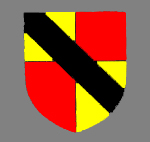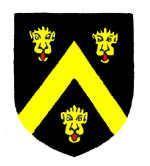The Manor of Chalgrave

The Barony of Bedford
The history of the manors of Chalgrave can be found in Volume III of The Victoria County History for Bedfordshire of 1912. From at least 1066 to 1086 Chalgrave Manor was held from the King by Albert of Lorraine but by 1168 the overlordship had passed to the Barony of Bedford. It is mentioned as late as 1615 when the Mowbray family were overlords.
Until 1386 the Manor of Chalgrave was held with that of Sharnbrook. Albert of Lorraine was a churchman, a chaplain who was a favourite both of King Edward the Confessor and King William I. About a century after Domesday the Loring or Loryng family were tenants of three out of four of Albert's Bedfordshire manors - Chalgrave, Wootton and Sharnbrook, all of which had become attached to the Barony of Bedford. This suggests some connection between Albert and the Lorings.

Loryng arms on the north arcade in the church June 2012
Chalgrave was the seat of the Loring family, the first of whom to be identified is Roger who died about 1185. At least one of the family is buried in Chalgrave church in a splendid tomb, with his likeness carved on top of the tomb chest. The last of the Lorings was Sir Nigel. He took part in the Hundred Years War fighting at the battles of Sluys in 1340 and Poitiers in 1356, both English victories. He was one of the original Knights of the Garter when the order was founded by King Edward III (1327-1377) in 1344. He retired to Chalgrave about 1365 and died about 1386. Sir Arthur Conan Doyle used the name as that of the hero for two books of mediaeval adventure - Sir Nigel and The White Company.

The Broughton family arms
Sir Nigel left two daughters, the younger of which, Margaret, wife of Thomas Pever of Toddington, inherited Chalgrave Manor. From that date, probably until the 19th century, Chalgrave Manor was held with Toddington Manor, the latter being the chief seat. Pever, in his will of 1429 left the manor to his daughter, wife of John Broughton, who may be the other knight buried in a magnificent tomb in the church. To Broughton himself he left the cattle of Chalgrave Manor "which Harry Wilde hath in keeping with his farm".
The last male heir of the Broughton family died in the early 16th century leaving a daughter, Anne, as heir. She married Sir Thomas Cheney in 1539. Their son married Jane, daughter to the chamberlain of King Henry VIII (1509-1547), Thomas, Lord Wentworth. He died without issue in 1587, his widow surviving until 1614 when the manor passed to her great-nephew Thomas, 4th Baron Wentworth, later 1st Earl of Cleveland.
The earl had a great many debts and, in 1641, tried to sell all his manors, requiring an Act of Parliament. An objection to Chalgrave's sale was raised by Tristram and Ellen Woodward, to whom Wentworth had mortgaged the manor. This is, tantalizingly, the last mention of the manor. Woodward and his wife had also objected to the sale of Toddington Manor and it is known that this objection was successful.

The Wentworth arms
If Chalgrave followed the same fate as Toddington, as seems reasonable to assume, it would have been sequestered in 1650, when Lord Wentworth, a Royalist, fled abroad after the defeat of King Charles I (1625-1649) in the English Civil War. His debts were found to be around £100,000, many millions in today's currency. The Earl of Cleveland returned to England on the restoration of Charles II (1660-1685), dying in 1667. His grand-daughter Henrietta Maria, Baroness Wentworth in her own right, was the mistresses of the Duke of Monmouth, for whom she is said to have raised money when he revolted against King James II (1685-1688) in 1685. She died the following year, the manor passing to her great-aunt Anne, Lady Lovelace, only surviving sister of her grandfather. She released it to her son John, Lord Hurley, in 1692. He died in 1693 and on his mother's death in 1697 the manor passed to John's daughter Martha, who became later Baroness Wentworth in her own right. She married Sir Henry Johnson, a rich shipbuilder, to whom the manor descended on her death.
Johnson had no issue with Lady Wentworth, leaving the manor to a daughter by a former marriage, who married Thomas Wentworth, 1st Earl of Strafford. On the death of their son William in 1791 their property was divided amongst his three sisters Anne Connolly, who seems to have had Chalgrave, Lucy Howard and Harriet Vernon. No more mention is made of the manor but Samuel and Daniel Lysons in their Magna Britannia of 1813 state that the manor was still held by the trustees of the late Thomas Connolly - Toddington Manor having been sold in 1806.
It is possible that the manor house for this manor was on or near the site of today's Manor Farm. If so it was was sold off separately at some point, becoming the mansion of the lesser Manor of Chalgrave, which was created from this manor before the end of the Middle Ages. Alternatively the manor house became the Chantry House early in the 15th century and, as the manors of Chalgrave and Toddington were held together, no mansion in Chalgrave was needed, the one in Toddington serving as mansion for both.